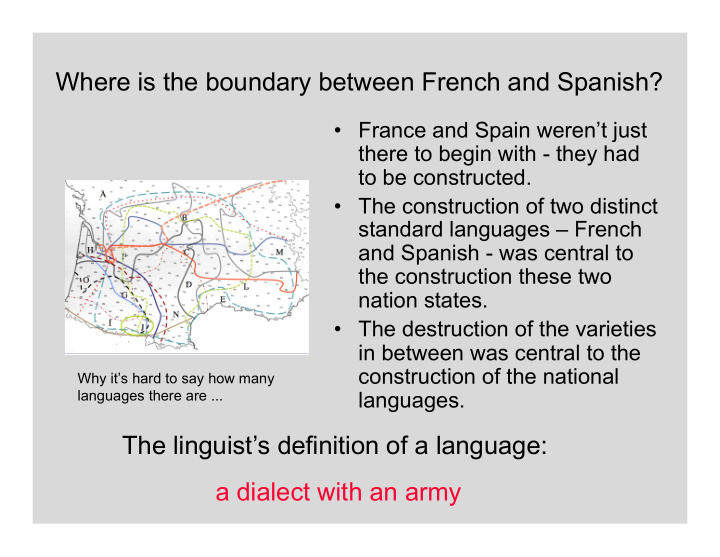



Where is the boundary between French and Spanish? • France and Spain weren’t just there to begin with - they had to be constructed. • The construction of two distinct standard languages – French and Spanish - was central to the construction these two nation states. • The destruction of the varieties in between was central to the construction of the national Why it’s hard to say how many languages there are ... languages. The linguist’s definition of a language: a dialect with an army
Language Shift • Usually involves languages with unequal power (“H and L”). • Diglossia – creates a linguistic division of labor in which the two languages are used in unequal domains. • This (along with other factors) results in the pejoration – and eventual death – of the less powerful language.
Tok Pisin in New Guinea • People coming back to villages from migrant work, introducing cosmopolitan status. • Missionaries Introducing hierarchy – Buying labor – Church hierarchy – Pejoration of native culture • ‘Satan is in the bush’
Language families of North America • According to a recent survey, only 194 languages remain. • Of these, 33 are spoken by both adults and children • Another 34 are spoken by adults, but by few children 73 are spoken almost entirely by adults over 50 • 49 are spoken only by a few people, mostly over 70 • 5 may have already become extinct. http://www.lsadc.org/info/ling-faqs-endanger.cfm
Language statuses • Safe – children will probably be speaking it in 100 years. • Endangered – children will probably not be speaking in 100 years. • Moribund – children are not speaking it now. • Extinct – Nobody’s speaking it.
Language families of Africa
Afro-Asiatic languages
Nilo-Saharan languages
Niger-Congo Languages
Khoisan Languages
How did Xhosa get its clicks? http://hctv.humnet.ucla.edu/departments/linguistics/VowelsandConsonants/course/chapter6/xhosa/xhosa.html Xhosa and Zulu (Nguni group) are Bantu languages with clicks. Clicks are not normally Bantu migration found in Bantu languages. and Nguni colonization of Southern Africa brought Nguni speakers into domination of Khoisan speakers. HERBERT, ROBERT K. 1990. The sociohistory of southern Bantu clicks. Anthropological linguistics, 32.120-38. IRVINE, JUDITH T. and GAL, SUSAN. 2000. Language ideology and linguistic differentiation. Regimes of language: Ideologies, politics, and identities, ed. by P.V. Kroskrity, 35-83. Santa Fe NM: SAR Press.
Hlonipha - showing respect in Nguni culture (a disappearing practice) • A general practice of modesty and respect towards affines (people related by marriage) and other revered persons. • Involves gesture, eye contact, expressions of affect, dress, and language. • Not pronouncing names of revered persons: – e.g. chief, certain affines.
An extreme English example from FINLAYSON, R. 1995. Women's language of respect: isihlonipho 279-96. Cape town and Johannesburg: David Philip. P. 279 � sabafazi. Language and social history, ed. by Rajend Mesthrie, • William Green’s parents: Grace will not eat green yogurt – Father - Robert Becomes something like: – Mother - Grace The older daughter of Smith • William’s wife can’t say the refuses to eat grass-colored principal syllables of these yomix. names: – rob ert green will grace
hlonipha strategies • Ellipsis umkhono > umono ‘foreleg’ • Synonymy kufa ‘to die’ > kushona ‘to set; to die’ • Derivation inkhuleko ‘thing for tethering’ for imbuti ‘goat’ • Consonant substitution – stem-initial C becomes coronal kho > to ‘thy’ – stem-initial C becomes click umlamu > umcamu ‘brother-in-law • It is speculated that clicks moved into more of the lexicon as, e.g., polite words lost their polite force.
Austronesian Languages
• More than half the languages spoken today have fewer than 10,000 speakers. • With the language goes the culture. • Measures: – Language Documentation – Language Revitalization
Recommend
More recommend